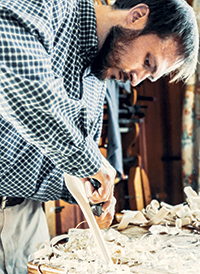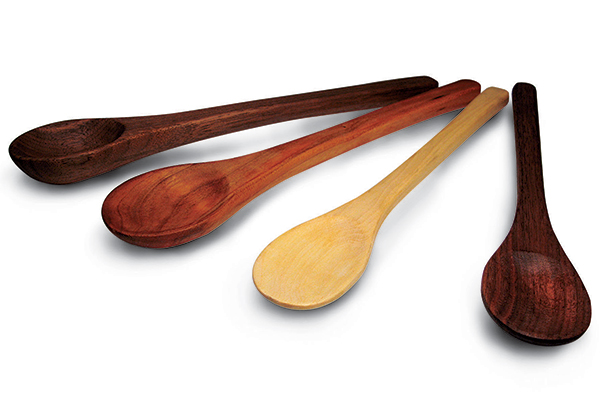
“Making a spoon is easy. Start with a piece of wood and remove everything that doesn’t look like a spoon.” — Steve Schuler, Author
Some years ago, my wife broke a cheap wooden spoon in the kitchen. She turned to me and asked, “How hard would it be for you to make a wooden spoon?” I had a few hand tools, and we began to experiment on whatever wood scraps we had on hand. Eventually I found out that traditional wooden spoons are lap-carved from green wood, but I was already well on my way to developing a method that worked well in dry hard- woods. I have since made hundreds of spoons and spatulas in many sizes, from two-foot-long stirring spoons to two-inch tasting spoons. Spoon making is also fast. Once you master the techniques, you can go from stock selection to applying the finish in one hour.
Stock Selection
Many hardwoods are appropriate for spoon making, but the finer the grain and the fewer open pores, the better. You can practice on white pine, but a hardwood spoon will stand up better to rough use in the kitchen. For your first spoon, choose an easily worked hardwood such as poplar, black walnut, soft maple or cherry. I have successfully used many woods, including pecan, Osage orange, Chinese tallow tree and mesquite. Once you get the hang of it, try harder woods like beech or hard maple. Eventually, you will seek out stock with bends and twists that seem to invite spoon making.
Select a straight, clear piece of wood 1/2″ to 3/4″ thick, 10″ to 12″ long, and 2″ to 3″ wide. The spoons in the lead photo (above) all started out with a piece of stock that was 3/4″ thick, and 12″ long. Your spoon size may vary to suit your personal preferences. It doesn’t matter if the stock is cupped or twisted, but there must be no checks in the end that will become the bowl. I’ll bet you already have an appropriate piece in your off-cut bin.
Design
First, make a template from cardstock. Good handles are usually no more than 3/4″ wide and are often thinner. The bowls of serving spoons are usually about 2″ wide and 3″ to 4″ long, while stirring spoons are smaller, having bowls about 11⁄2″ wide and no more than 3″ long. But let your personal preferences guide you. Some people like handles with parallel sides, while others like ones that swell at the end and taper toward the bowl. Serving spoons have wide, deep bowls but often have short handles. Mixing spoons require shallow bowls and stout handles.
An easy way to make a template is to draw a centerline on a piece of paper, draw half the profile of your spoon on one side of the line, fold the paper on the line, and cut out your profile. Unfold the paper, and you have a perfectly symmetrical template. After I had made a couple of dozen spoons and knew what shapes I liked best, I made several wooden templates to speed this task.
Plane down one face of the wood to make the layout lines easy to see. Draw out your spoon design on your stock, ensuring that the grain runs straight through the entire spoon. It may help to draw a center line down the bowl of the spoon. Sketch out the inside of the bowl freehand, leaving a rim of about 1/16″.
Begin by Dishing the Bowl
It is best to shape the inside of the bowl first, then the handle, and finally the out- side of the bowl. That way, you will always have parallel surfaces to clamp securely in the vise as you shape the spoon. Secure your stock in the vise and hold your gouge in both hands.
A sharp gouge will cut well both with the grain and across it. Make your roughing cuts across the grain and your finishing cuts with the grain. To rough out the bowl, place the gouge on one end of the bowl near the centerline. As you push the edge into the wood, move the handle laterally, making a slicing cut. Repeat, using overlapping strokes, until you get to the other end of the bowl. Turn the stock around in the vise and work the other side. Gradually work back to your layout lines. Now take light cuts with the grain, beginning at the front of the bowl. The bowl should slope gradually from front to back. Get the surface as smooth as you can with the gouge.
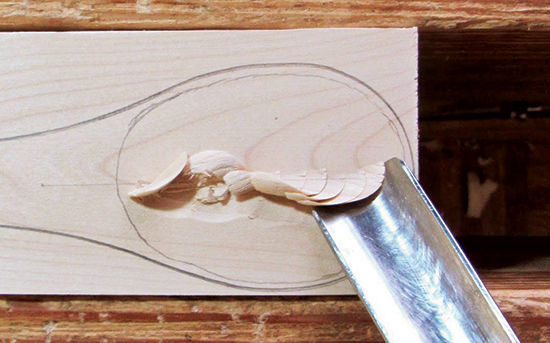
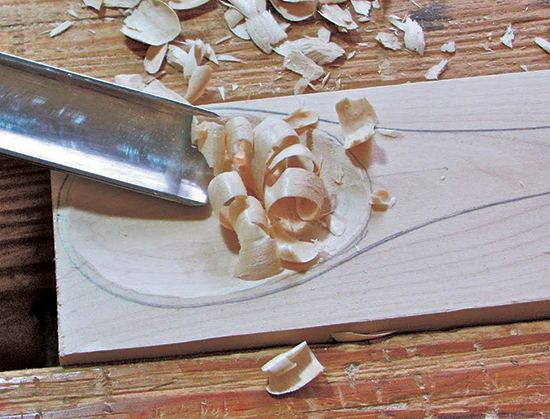
Shape the Handle
The most comfortable handle shape is either flat and wide or half-round in cross-section, with the flat on the top of the handle. Use your preferred method for cutting curves to rough out the handle and the outside profile of the bowl. I use a drawknife, but a band saw will work, too. If you choose to use a drawknife, remember: when creating a flat or concave surface, use it with the bevel down. When shaping a convex surface, use it with the bevel up.
With the bulk of the waste removed, use a spokeshave to shape the handle. Depending on grain direction, you may need to either push or pull the spokeshave. Begin with the sides of the handle, working down to the layout lines. On the shoulders, use a scooping motion when working concave surfaces with a spokeshave, rolling the spokeshave backward slightly on each stroke. Next, chamfer the underside edges of the handle. Then relieve each of the six corners, rounding the underside of the handle as evenly as possible.
At this point, it is possible to make the handle too thin and delicate, but beginning spoon carvers are more likely to err on the fat side. Shape the handle so that it’s comfortable in your hand — the layout lines are a visual guide, but trust your hands, too. As the handle thins down, you will feel it flexing beneath your tools, and you may feel you are going to break it. Don’t worry. If the spoon survives the process of its own making, it will survive for many years in the kitchen.
You don’t have to round over the end of the handle, but it looks nice. If you must, you can drill a hole in the end for hanging, but most people keep their spoons in drawers or canisters.
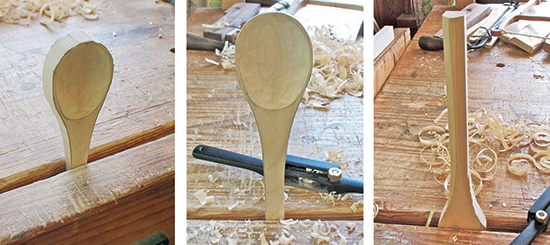
Shape the Outside of the Bowl
Now turn the spoon around in the vise and work on the outside of the bowl. Use a drawknife or handsaw to shape three large chamfers, two on each side and one on the end. Use a spokeshave to round over the edges of the facets. Start each cut at one side of the bowl and follow the edge of the stock up to the center. After a few strokes on one side, move to the opposite side. Quick, light strokes work best.
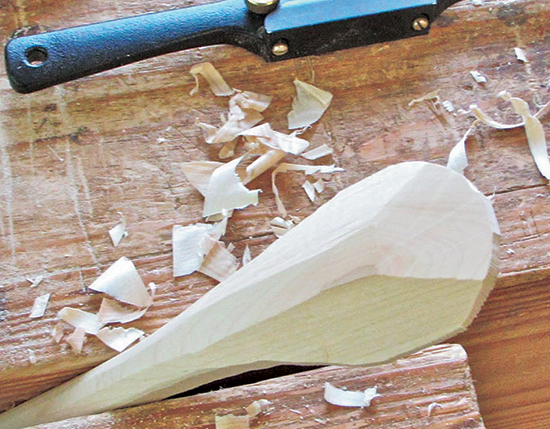
As you shape the outside of the bowl, pause regularly to gauge the thickness of the bowl by pinching it between your fingers. Between 3/16″ and 1/8″ thick is ideal. In theory, the outside of the bowl should be the same shape as the inside, and it should be the same thickness from the tip to the shoulders. In practice, the thickness can vary quite a bit front to back. Just make sure not to leave too much wood on the underside of the bowl, especially near the rim. The underside of a spoon should slope gently so that it will easily scrape the bottom of a pan or the inside of a mixing bowl.
Finally, use the spokeshave to narrow down the shoulders. Use the same scooping motion you used on the sides. Aim to remove wood from the shoulders without continuing to thin down the handle. It is easy to leave too much wood here, making for a heavy, bulky spoon in use. A half-round rasp is a good alternative to the spokeshave.
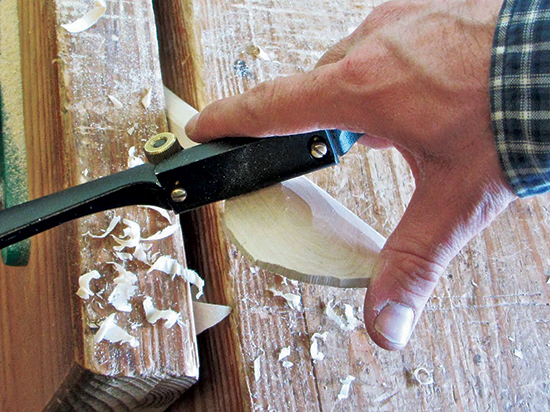
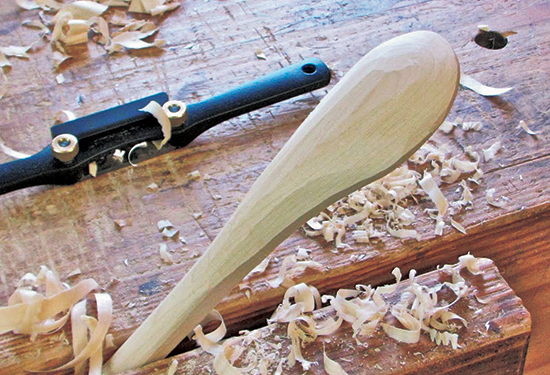
As you work, periodically take the workpiece out of the vise and look at it from a variety of angles — from the top, from the side, and down the length — to ensure that you have not left lumps or bumps anywhere. The bottom of the bowl should dip down below the line of the handle, and the handle should be either straight or curved downward slightly.
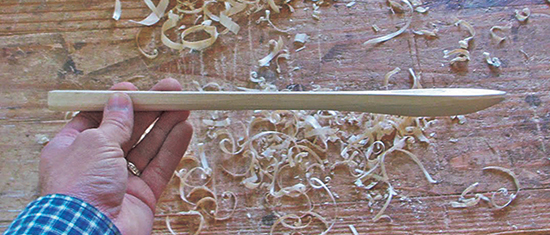
Finishing
Once the spoon is a satisfactory shape, use card scrapers to remove tool marks and tearout. I use a curved card scraper for the inside of the bowl. For everything else, I use a thin, straight card scraper, bent between my fingers. Use long, gentle strokes to blend the lines into each other and remove the remnants of your layout lines. The only flat surface should be on the top of the handle, where the thumb will rest in use. After sanding to 220-grit, apply a nontoxic oil finish.
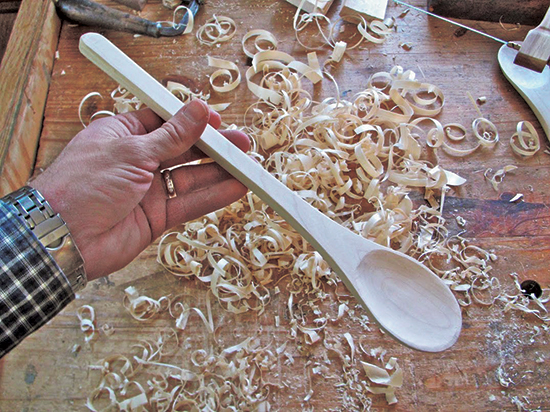
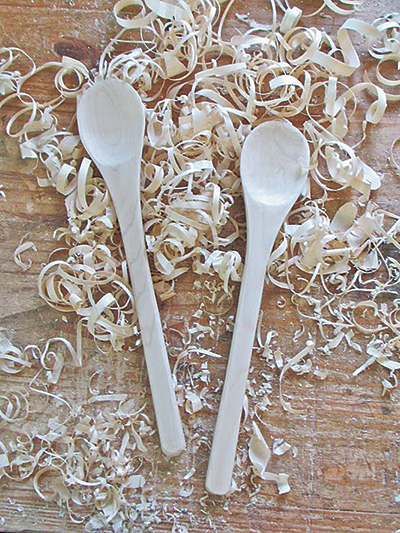
Wooden spoons should be hand washed with regular soap and water. Do not let them soak for a long time in water, and never put them in the dishwasher, which will cause the wood to deteriorate quickly. A good spoon should last in the kitchen for many years, but eventually it will wear out. If cracks develop in the bowl, it’s time to retire your spoon. Then it’s time to make another one.
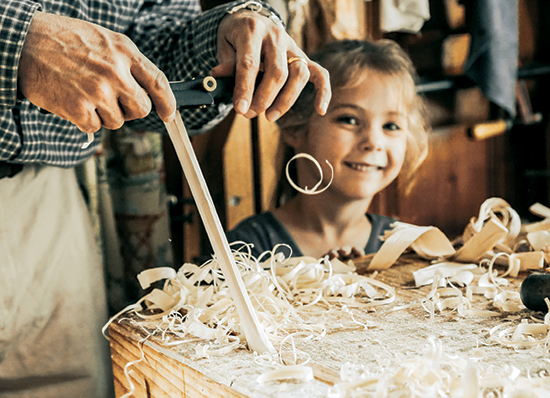
Steve Schuler is a professor of English at an Alabama liberal arts college and an amateur woodworker who works almost entirely with hand tools.
